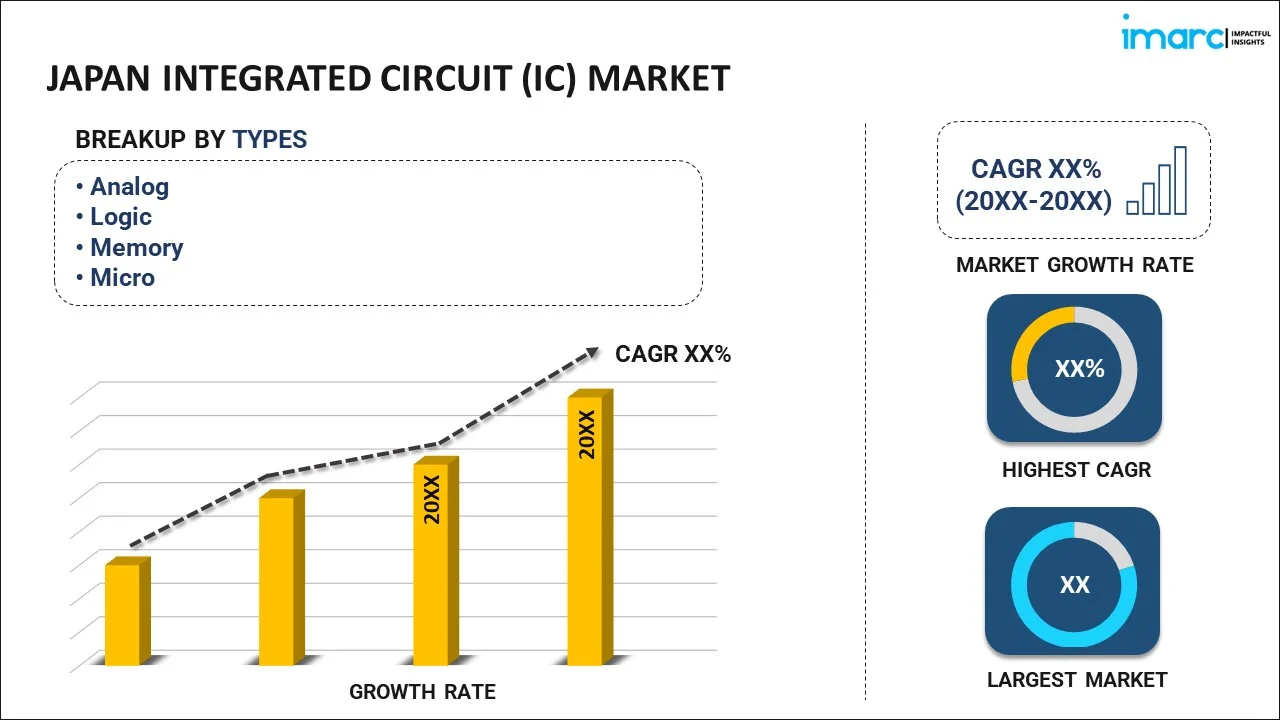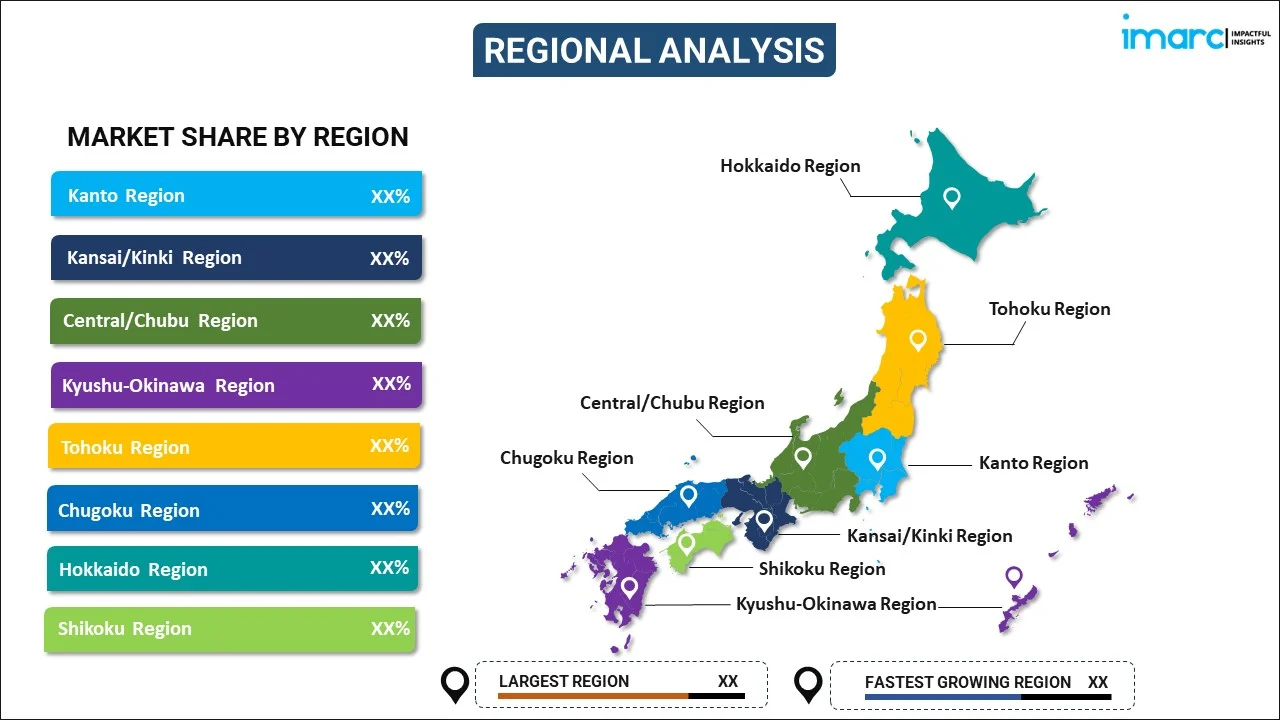
Japan Integrated Circuit (IC) Market Report by Type (Analog, Logic, Memory, Micro), Application (Consumer Electronics, Automotive, IT and Telecommunications, Industrial, Others), and Region 2025-2033
Market Overview:
Japan integrated circuit (IC) market size reached USD 40.7 Billion in 2024. Looking forward, IMARC Group expects the market to reach USD 83.6 Billion by 2033, exhibiting a growth rate (CAGR) of 7.70% during 2025-2033. The rising demand for electronics products, such as smartphones, tablets, laptops, and smart appliances that require increasingly sophisticated ICs to support their functionality and performance is driving the market growth.
|
Report Attribute
|
Key Statistics
|
|---|---|
|
Base Year
|
2024 |
|
Forecast Years
|
2025-2033
|
|
Historical Years
|
2019-2024
|
| Market Size in 2024 | USD 40.7 Billion |
| Market Forecast in 2033 | USD 83.6 Billion |
| Market Growth Rate (2025-2033) | 7.70% |
Integrated circuit (IC), often referred to as microchips or simply chips, represents the backbone of modern electronics. They are essentially miniature electronic circuits etched onto a tiny piece of semiconductor material, typically silicon. They contain transistors, resistors, capacitors, and numerous other electronic components, all integrated into a single package. ICs come in various types and sizes, from simple logic gates to complex microprocessors that power computers and smartphones. Their compactness, reliability, and energy efficiency make them indispensable in nearly every electronic device. Whether it's a smartphone, a car's engine control unit, or a spacecraft's navigation system, ICs enable precise control and rapid data processing. The continuous advancement in IC technology has led to ever-smaller and more powerful chips, driving innovations across various industries, from healthcare and telecommunications to automotive and aerospace. IC plays a pivotal role in shaping the future of technology, enabling new possibilities, and enhancing daily lives.
Japan Integrated Circuit (IC) Market Trends:
The integrated circuit (IC) market in Japan is experiencing robust growth due to several interconnected factors. Firstly, the rapid proliferation of consumer electronics, including smartphones, tablets, and wearable devices, has driven the demand for more advanced and power-efficient ICs. Moreover, the emerging popularity of Internet of Things (IoT) has further amplified this demand, as countless IoT devices rely on ICs for processing and connectivity. In addition to this, the automotive industry's increasing integration of advanced electronics for autonomous driving, infotainment systems, and electric vehicles has significantly contributed to the expansion of the IC market. Furthermore, the growing awareness of environmental concerns has led to a rise in demand for energy-efficient ICs, fostering innovation in this sector. Additionally, the ongoing development of 5G networks has propelled the need for ICs that can handle higher data speeds and lower latency. This, in turn, is expected to drive the integrated circuit (IC) market in Japan during the forecast period.
Japan Integrated Circuit (IC) Market Segmentation:
IMARC Group provides an analysis of the key trends in each segment of the market, along with forecasts at the country level for 2025-2033. Our report has categorized the market based on type and application.
Type Insights:

- Analog
- General-purpose IC
- Application-specific IC
- Logic
- TTL (Transistor Transistor Logic)
- CMOS (Complementary Metal Oxide Semiconductor)
- Mixed-Signal IC
- Memory
- DRAM
- Flash
- Others
- Micro
- Microprocessors (MPU)
- Microcontrollers (MCU)
- Digital Signal Processors
The report has provided a detailed breakup and analysis of the market based on the type. This includes analog (general-purpose IC and application-specific IC), logic (TTL (transistor transistor logic), CMOS (complementary metal oxide semiconductor), and mixed-signal IC), memory (DRAM, flash, and others), and micro (microprocessors (MPU), microcontrollers (MCU), and digital signal processors).
Application Insights:
- Consumer Electronics
- Automotive
- IT and Telecommunications
- Industrial
- Others
A detailed breakup and analysis of the market based on the application have also been provided in the report. This includes consumer electronics, automotive, IT and telecommunications, industrial, and others.
Regional Insights:

- Kanto Region
- Kansai/Kinki Region
- Central/ Chubu Region
- Kyushu-Okinawa Region
- Tohoku Region
- Chugoku Region
- Hokkaido Region
- Shikoku Region
The report has also provided a comprehensive analysis of all the major regional markets, which include Kanto Region, Kansai/Kinki Region, Central/ Chubu Region, Kyushu-Okinawa Region, Tohoku Region, Chugoku Region, Hokkaido Region, and Shikoku Region.
Competitive Landscape:
The market research report has also provided a comprehensive analysis of the competitive landscape. Competitive analysis such as market structure, key player positioning, top winning strategies, competitive dashboard, and company evaluation quadrant has been covered in the report. Also, detailed profiles of all major companies have been provided.
Japan Integrated Circuit (IC) Market Report Coverage:
| Report Features | Details |
|---|---|
| Base Year of the Analysis | 2024 |
| Historical Period | 2019-2024 |
| Forecast Period | 2025-2033 |
| Units | Billion USD |
| Scope of the Report | Exploration of Historical and Forecast Trends, Industry Catalysts and Challenges, Segment-Wise Historical and Predictive Market Assessment:
|
| Types Covered |
|
| Applications Covered | Consumer Electronics, Automotive, IT and Telecommunications, Industrial, Others |
| Regions Covered | Kanto Region, Kansai/Kinki Region, Central/ Chubu Region, Kyushu-Okinawa Region, Tohoku Region, Chugoku Region, Hokkaido Region, Shikoku Region |
| Customization Scope | 10% Free Customization |
| Post-Sale Analyst Support | 10-12 Weeks |
| Delivery Format | PDF and Excel through Email (We can also provide the editable version of the report in PPT/Word format on special request) |
Key Questions Answered in This Report:
- How has the Japan integrated circuit (IC) market performed so far and how will it perform in the coming years?
- What has been the impact of COVID-19 on the Japan integrated circuit (IC) market?
- What is the breakup of the Japan integrated circuit (IC) market on the basis of type?
- What is the breakup of the Japan integrated circuit (IC) market on the basis of application?
- What are the various stages in the value chain of the Japan integrated circuit (IC) market?
- What are the key driving factors and challenges in the integrated circuit (IC)?
- What is the structure of the Japan integrated circuit (IC) market and who are the key players?
- What is the degree of competition in the Japan integrated circuit (IC) market?
Key Benefits for Stakeholders:
- IMARC’s industry report offers a comprehensive quantitative analysis of various market segments, historical and current market trends, market forecasts, and dynamics of the Japan integrated circuit (IC) market from 2019-2033.
- The research report provides the latest information on the market drivers, challenges, and opportunities in the Japan integrated circuit (IC) market.
- Porter's five forces analysis assist stakeholders in assessing the impact of new entrants, competitive rivalry, supplier power, buyer power, and the threat of substitution. It helps stakeholders to analyze the level of competition within the Japan integrated circuit (IC) industry and its attractiveness.
- Competitive landscape allows stakeholders to understand their competitive environment and provides an insight into the current positions of key players in the market.
Need more help?
- Speak to our experienced analysts for insights on the current market scenarios.
- Include additional segments and countries to customize the report as per your requirement.
- Gain an unparalleled competitive advantage in your domain by understanding how to utilize the report and positively impacting your operations and revenue.
- For further assistance, please connect with our analysts.
 Inquire Before Buying
Inquire Before Buying
 Speak to an Analyst
Speak to an Analyst
 Request Brochure
Request Brochure
 Request Customization
Request Customization




.webp)




.webp)












